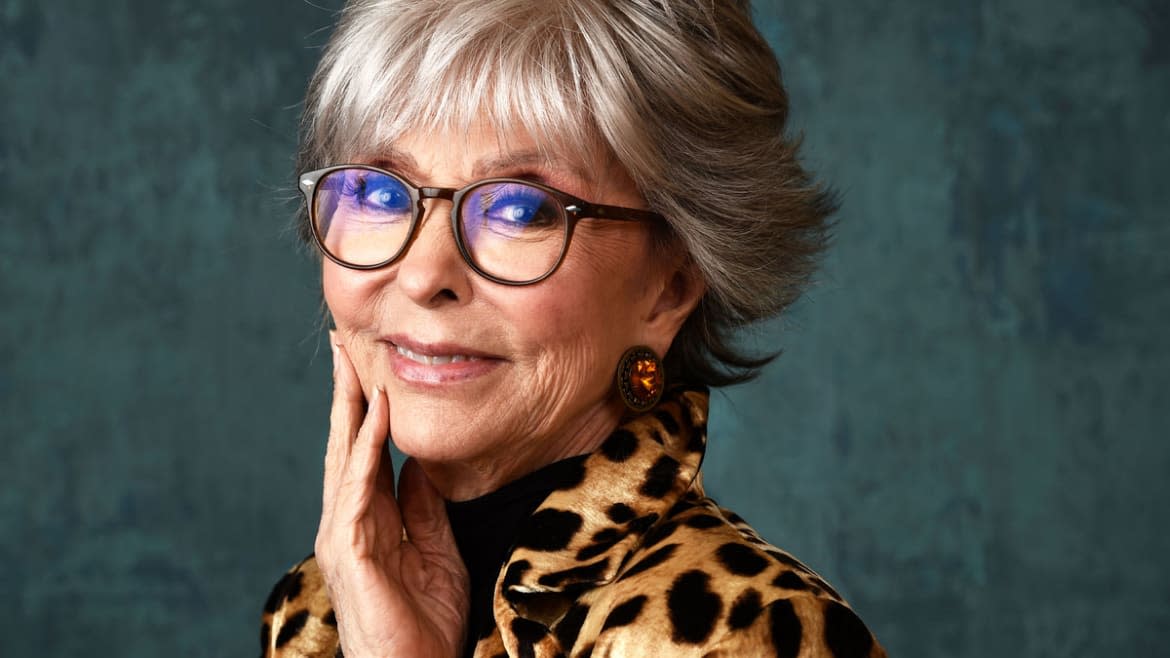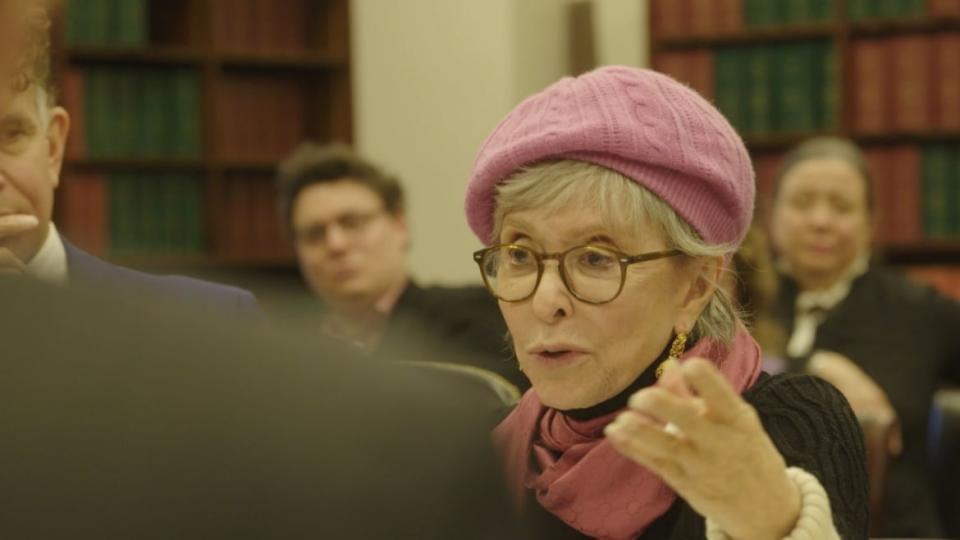Rita Moreno Dishes on Marlon Brando, ‘West Side Story,’ and Hollywood Racism

- Oops!Something went wrong.Please try again later.
- Oops!Something went wrong.Please try again later.
- Oops!Something went wrong.Please try again later.
It’s a rich question coming from a legendary performer who once also had a years-long, tumultuous affair with Marlon Brando, but Rita Moreno insists that she asked it anyway—or at least thought it. When Brent Miller, a producer of the newly debuted Sundance documentary Rita Moreno: Just a Girl Who Decided to Go for It, first approached her with the idea, Moreno said, “I really was tempted to say, ‘Um, really?’ What’s so interesting about me?”
“You have to know me to believe that, I know,” Moreno grants during an interview with The Daily Beast. And indeed, these kinds of statements do tend to reek of false modesty. But given the experiences that shaped her life and career, it’s actually not too hard to believe.
After more than 50 years in Hollywood, Moreno is long overdue for the documentary treatment. And director Mariem Pérez Riera, mother of Marcel Ruiz (who plays Moreno’s grandson in the recent One Day at a Time reboot), offers a fascinating window into Moreno as both a person and a part of Hollywood history.
Pérez Riera actually had Moreno in mind as she wrote certain female characters in her 2007 film Maldeamores (Lovesickness). When her son first landed his role alongside Moreno, she recalled, she sat him down for a viewing of West Side Story. Once production began, “He would come home and say, ‘Do you know that Rita dated so and so,’ and this and that,” the director recalled, noting that she’d also observed Moreno when she came to set with Marcel. “But it wasn’t until I realized that I was going to make the documentary that I decided to observe her even closer.”
The documentary hits all of the juicy anecdotes a Moreno devotee would expect, and the actress’ candid interviews are (obviously) a delight, as is footage of the actress goofing around and eating blintzes on set at One Day at a Time. But the bulk of Pérez Riera’s film explores Moreno’s legacy through another lens—the sexism and racism she faced throughout her life and career.
“I think nobody knows exactly what [she] went through,” Pérez Riera told The Daily Beast. “In general, you only see the highlights of [actors’] careers, but you don’t necessarily know what was behind all her facade. And she carried a lot of different facades during her path to stardom.”

There were basically no visible Latinx performers in the industry whose footsteps Moreno could follow. So when she landed a meeting with MGM boss Louis B. Mayer at the age of 17, Moreno styled herself like Elizabeth Taylor. She coiffed her hair into that iconic bob and begged her mother to buy her a waist cincher—and she rejoiced when Mayer exclaimed, “This looks like a Spanish Elizabeth Taylor!”
“I thought, wow, that’s what I was aiming for,” Moreno said of landing her MGM contract. “But it didn’t turn out that way.”
Like Rita Hayworth, who began using her mother’s maiden name partway through her career after her Spanish-American father’s last name, “Cansino,” kept relegating her to “exotic” roles, Moreno consistently found herself playing characters that required her to be painted dark brown and speak with an accent. She played characters of countless ancestries, and developed an unchanging “universal ‘ethnic’ accent” that she used across them all. Singin’ in the Rain gave her better material to work with as the “it” girl Zelda Zanders, but then it was back to the same as before.
“Ultimately it just broke my heart,” Moreno said. “It got to the point where I couldn’t do anything unless I had an accent.” The non-stop parade of degrading roles brought back Moreno’s childhood memories of being bullied with racist insults on her way to school. “I never told my mom about this because instinctively I knew there was nothing she could do about it,” Moreno said. “I mean, what’s she going to do? Walk me to school? My mom had a job.”
In 1961, however, Moreno’s life hit two major turning points.
First, while making West Side Story, she was able to find a role model in her character, Anita—a self-possessed woman with an uncrushable spirit. Once again, Moreno was stuck under that brown makeup, and forced to talk writers through why she didn’t feel comfortable with lines like the original musical lyric, “Puerto Rico/ You ugly island/ Island of tropic diseases...” But this time, her dancing chops, comedic timing, and power as a dramatic actress made her talent undeniable—and forced an industry that for so long had treated her as “starlet” arm candy to regard her as a real performer.

But it was also in 1961, after production on West Side Story had wrapped, that Moreno attempted to kill herself with sleeping pills in Brando’s apartment, after enduring the actor’s numerous affairs, emotional abuse, and a botched abortion.
Ironically, it had been Brando who’d urged Moreno into therapy in the first place. He’d seen her on a local television panel, which she’d spent, as she put it, “being what I thought was interesting and exciting and sexy.” Brando, however, told her that he’d watched the appearance “with great sadness... And he was absolutely right, of course.”
Moreno heeded Brando’s advice, spending years doing psychotherapy and group therapy on and off. Still, she won’t let her late ex have too much credit. “It’s probably the best thing I've ever done for myself, but I always think it’s hilarious that the other looney said I needed help,” Moreno said with a laugh. “He was always telling people [to go to therapy]; he was usually right. But so what... Fuck off, Marlon!”
After she survived her suicide attempt, Moreno worked to embrace her own value, both as a person and a performer. As Pérez Riera put it, “She decided that she was going to live, and she decided that she was going to continue going through therapy to become a better person and a better human being. Of course, it is very important.”
After West Side Story and her historic Oscar win, Moreno began to refuse those demeaning “dusky maiden” roles that had so eroded her self worth as an actress. As a result, she didn’t appear in movies for several years.
But in the 1970s, Moreno began to receive the recognition she deserved. In 1973, she and her co-stars on the kids’ show The Electric Company won a Grammy for best album for children. Two years later, Moreno won her Tony for The Ritz—in which she played a clueless aspiring actress named Googie Gomez. (Moreno later reprised her role in the film adaptation.) A Muppet Show appearance won Moreno her first Emmy in 1977, and a year later she brought home another for her turn in the detective drama The Rockford Files.

The glow of these honors resonated far beyond Moreno herself. Pérez Riera still remembers watching West Side Story, the movie that won the first Puerto Rican woman her Oscar, for the first time. “She’s an icon to me and many Puerto Ricans,” the director said, “because she’s someone who reached something that we felt it was not possible to reach.”
Despite the prejudice she faced for so many decades, all of which Moreno says “absolutely messed with my self-conception,” the actress does not reveal even a hint of bitterness. These days she’s as happy as “an uneaten clam,” and looking forward to celebrating her 90th birthday. She nourishes her unending appetite for laughter with comedies like Key & Peele. (Among her favorite sketches: the one where Jordan Peele plays a stubborn flight attendant and, in Moreno’s words, an “officious prick” who won’t let Keegan-Michael Key use the bathroom. “Hilarious isn’t a good enough word, but I don't know any other,” Moreno said of the sketch. “I mean, I was peeing my knickers.”)
And of course, Moreno also is eagerly awaiting the release of Steven Spielberg’s long-awaited West Side Story remake—which she both appears in and executive produced, and which turned out to be one of the most fun projects of her career.
Moreno loved palling around with the young dancers on set, and doing bits with them during their laughably minuscule 10-minute breaks between two-hour dance sessions. “Maybe it has to do with the fact that we work so hard,” she said, adding with a laugh, “You’re a dancer, you’re used to being abused.”
The other project Moreno cites as her most rewarding? One Day at a Time, the Cuban American Norman Lear reboot that premiered on Netflix in 2017. Moreno’s performance as a loving but exacting send-up of Latina abuelas everywhere is a marvel even within her impressive career. And unlike all those past productions that put her in brownface, Latinos called the shots on One Day at a Time—from Cuban co-creator Gloria Calderón Kellett to the writers room, where half the staff was Latino from the beginning. The jokes land because they’re written from within the community, about ourselves. And this time, Moreno’s accent is not a faceless affectation; she is imitating her own mother’s voice.
Perhaps that’s why, toward the end of our conversation, Moreno shared one specific recollection with such joy. At one point while the show was taping, she met a 5-year-old fan who seemed absolutely tickled by her presence. The girl told her that Lydia was her favorite character on the show—and launched into an uncanny impression.
“She’s a little 5-year-old person,” Moreno said with audible delight. “And she put her hands on her little hips, and she looked way up at me and she says, ‘What are ju, crazy, or what?!’”
“I nearly fell over,” Moreno said. “She was so adorable. And the accent was perfect.”
Get our top stories in your inbox every day. Sign up now!
Daily Beast Membership: Beast Inside goes deeper on the stories that matter to you. Learn more.

